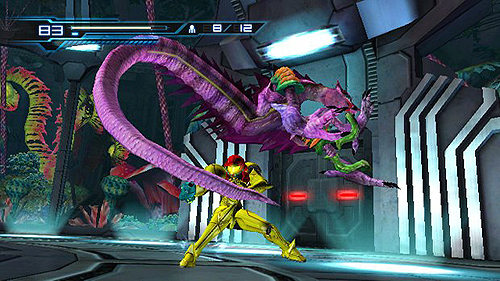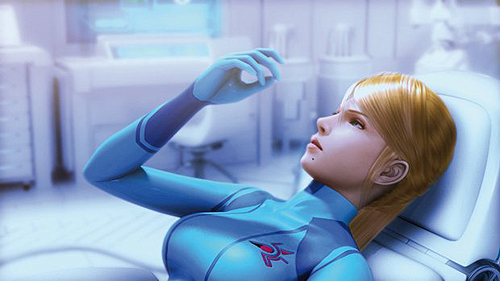When it was announced at E3 in 2001 that Retro Studios would be developing the (then) next installment in the Metroid series, Metroid Prime, it was shocking to hear that the game would be played from a first person perspective. Considering it was being developed by a third-party studio, rather than by Nintendo, I was already a bit skeptical. It is a series that is taken quite seriously by fans, and they hold it to fairly high standards. When I finally played the game, I was relieved to find that it captured the feel of previous Metroid titles, and for the most part, critics agreed. Metroid Prime won Game of the Year for 2002 from nearly every major publication.
When it came to light that Ninja Gaiden developer, Team Ninja, was developing Metroid: Other M for the Wii, it seemed like a perfect mashup of gaming legends. It had the added benefit of being a sequel to fan favorite Super Metroid. As a Metroid fan myself, having completed the game leaves me with mixed feelings. The gameplay feels like the magical Ninja/Metroid hybrid I was hoping for, but the writing and heavy handed narrative tarnish the mood and hold the game back from being a perfect Metroid sequel. Story The game starts out where Super Metroid left off, at the height of the epic battle between Mother Brain and the bounty-huntress, Samus. Those unfamiliar with the characters may not find this as compelling or nostalgic as some, but the intro sequence is engaging and action packed enough to draw in newcomers to the Metroid saga.
As it goes, Samus defeats Mother Brain with the self-sacrifice of a baby Metroid. She destroys the home planet of the Metroid species, and escapes before the explosion engulfs her ship. One day, she intercepts a signal that sounds remarkably like that which brought her to Zebes years ago. Of course, she can’t help but satisfy her curiosity, and travels to origin of the signal, the “Bottle Ship”.
This is where things take a turn for the worse. Upon her arrival, she soon runs into a fleet of soldiers from the Galactic Federation, including her old commander, Adam Malkovich. In order to proceed with her mission, she has to effectively rejoin the ranks under Adam, something which deviates completely from the traditional Metroid formula.
In previous games, the appeal of Samus was that of a lone heroine: silent, deadly, and determined. She wandered through untraveled territory and explored the depths of planets with hopes of discovering new tools to aid her in her quest. In Other M, the player has to be given permission from Adam to use the upgrades acquired in Super Metroid, rather than earning them through effort and strife. It would obviously seem silly if Samus rediscovered the same upgrades in a sequel, but this move also saved developers from coming up with new ideas. The writers justified it by having Adam claim that certain tools would prove dangerous in a spaceship environment, but that too feels like a cop out.
The inclusion of the Federation ultimately comes full circle, but its inclusion feels like a distraction from what makes Metroid games what they are. The same goes for the cut-scenes and narratives that reveal Samus’s history as a cadet and her relationship with Adam. It all feels unnecessary and too similar to mid-grade anime fodder. You can clearly feel the Japanese influence of Team Ninja, and it feels stilted and forced compared to the three Prime games from Retro Studios.
Gameplay Story and cut scenes aside, Other M is a very fun game, Metroid or otherwise. Team Ninja uses a fixed camera for the game that allows players to explore fully 3D environments or fly through linear sections with ease. They managed to capture the pacing of previous Metroid titles and Samus’ lethal-nature is in full force. There is a healthy mix of puzzles and platforming, aided in large part to the unique control scheme.
Team Ninja boldly confined the controls to the WiiMote, and they succeed in getting the most out of the simple configuration. When held horizontally, Players navigate in a third person perspective, but point the WiiMote at the screen, and it flips to a first person view. While you cannot move when in helmet mode, you can visually explore the ship in ways that you couldn’t otherwise. It also gives you an opportunity to lock on to enemies and use certain weapon upgrades that are disabled in the other mode. The first person view is adequate, but I can’t help but feel that using the Nunjuk could have solved some of these limitations. It is acceptable, but only because the method of switching between views is clever and feels natural from the get-go.
When in the third person perspective, Samus auto locks onto enemies, and does so without discretion to proximity. In a way, it removes some of the skill required in previous games, but with the fixed camera, it is a necessity. Team Ninja also added a few new elements to Samus’ repertoire that feel like they were taken right from Ninja Gaiden. Samus has the ability to use “sense move”, which acts as a dodge and counter attack when executed at the right time. All you have to do is press a direction on the d-pad when an enemy or projectile is about to hit Samus, and she dives in that direction, receives a full blaster charge, and fires at the unsuspecting foe. It’s a tactic that works, but also happens more often than intended. You also have the ability to perform lethal attacks by running towards downed or stunned enemies and pressing the action button, resulting in an acrobatic and murderous maneuver. It’s a rewarding maneuver that is nothing like we’ve seen in another Metroid game.
The automated nature of the controls does make enemy encounters feel easy at times, but there are still bosses that will frustrate players and moments when the sheer number of enemies can feel a bit overwhelming. I only died once during my playthrough, however, and it was more of a fluke than anything. Even when you are running out of missiles, you can hold the WiiMote vertically and recharge your ammunition. If you think it can’t get any easier, when you are hit for what seems like the last time, you actually get a second chance to stay alive, before another hit eventually results in death. All of this is cheap and might leave a few gamers wondering where the challenging nature of Super Metroid and Prime went.
Graphics Other M is one of the best looking games on the Wii and there is little room for noticeable improvement. The ship is thoroughly detailed and lighting effects add gloomy touches to the already dark atmosphere. Samus’ model looks great and she is animated beautifully. Honestly, it’s hard to find any flaws in the graphic technology used in the game. It successfully captures the aesthetic defined in other Metroids It does seem odd that there are certain sections of the ship that appear traversable, yet are inexplicably off limits to Samus, but this has more to do with level design rather than the look of the game, and only happens once in a while.
Sound Team Ninja was able to retain the downplayed soundtrack one would expect of a game taking place in outer space. At times, it’s integrated so well that you don’t notice it unless you listen for it. Likewise, sound effects are very similar to those found in Metroid Prime and Super Metroid. There are a few instances of repurposed stock sound effects that are momentarily distracting but it doesn’t detract from the total ambiance.
Conclusion Metroid: Other M is indeed plagued by an unnecessary amount of storylines and cut scenes, but they only hurt the game when compared to the near perfect Super Metroid and Metroid Prime. The gameplay feels like a fresh take on the Metroid formula, and the new inclusions works quite well, even if they exist solely to make up for the fixed camera. It holds up as a solid 3D action title, and is worthy of any Wii gamers’ attention. As a new entry in one of Nintendo’s legacy series, it makes the grade and should make any Metroid fan very happy. Team Ninja’s involvement has paid off and I, for one, hope they have another Metroid title in the pipeline.





